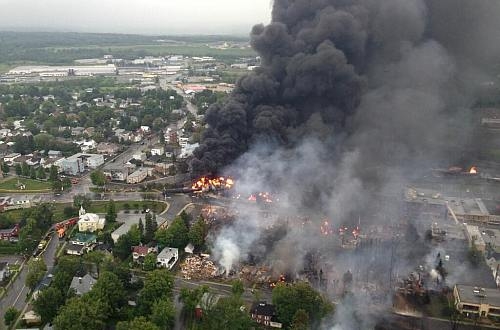The train was carrying 7.7 million litres of mislabeled crude oil from North Dakota's Bakken shale formation to the Irving Oil refinery at Saint John, New Brunswick, when the accident occurred.
Aside from advising Transport Canada to meet its responsibilities as national rail regulator, Canada's Transportation Safety Board (TSB) had just one new recommendation in its final investigation report, which was published on August 19. The report suggests that parked locomotives trailing dangerous goods should be secured by chocks, derailers, or advanced braking systems. Current regulation does not require the sort of physical restraint that would have prevented the Lac-Mégantic runaway.
The causes identified by the TSB were poor locomotive maintenance and inadequate securing of the train, for which the safety board blames the now-defunct railway company (since taken over by Fortress Investment Group and re-launched as the Central Maine & Quebec Railway).
The train was parked on a through line on a descending gradient, with the lead locomotive idling and seven hand brakes set. A fire broke out in an engine that had been causing problems for several days prior to the incident. Emergency services shut off the engine, but then the air holding the locomotive brakes leaked off. With the hand brakes providing insufficient force, the train began its tragic descent downhill.
TSB chair Mrs Wendy Tadros told reporters on August 19 that employee responsibility is the last line of defence in railway safety, and not one that can substitute for management supervision and government oversight. She notes that MM&A was weakly managed and that the federal regulator did little to police the railway.
"This was a company with a weak safety culture, a company where people did what was needed to get the job done, rather than always follow the rules," Tadros explains. "A company where unsafe conditions and unsafe practices were allowed to continue. Which begs a question: Who, then, was in a position to check on this company to make sure safety standards were being met? Who was the guardian of public safety? That's the role of government – to provide checks and balances. And yet this booming industry – where block trains were shipping more and more oil across Canada, and across the border, ran largely un-checked. Yes, Transport Canada knew about some of the problems at MM&A, but the follow-up wasn't always there."
TSB investigators released their report at the scene of the accident in which 47 people were killed and 2000 displaced from their homes, and pointed the finger of blame squarely at Transport Canada.
"If the guard dog doesn't do its job, then indeed it is to blame," says TSB chief operating officer Mr Jean Laporte when asked to say directly whether Transport Canada was the culprit-in-chief.
"There has to be a change in the Canadian railway industry," said Tadros. "The increase in moving shipments of oil by rail took many by surprise, including the regulator. This accident will bring about a sea change in thinking by the railway industry, the shippers, and the regulators."
The TSB had earlier issued emergency interim recommendations governing railway operations, each of which was rapidly implemented by Transport Canada. The regulator has previously been criticised by the country's auditor general for failing to do its job and by the information commissioner for its regime of secrecy and obstruction of freedom of information legislation.
The interim recommendations included enhanced safety standards for DOT-111 tank wagons, requirements for railways to conduct safety-driver route planning and for emergency response plans for the carriage of liquid hydrocarbons by rail. Each of those recommendations was subsequently adopted by Transport Canada.
The TSB final report contains only two additional recommendations, the first that Transport Canada actually audit and inspect implementation of the "safety management systems" introduced in 2001 when direct government rulemaking was replaced by self-regulation. The TSB's only new operational recommendation is that Canada adopt recent US National Transportation Safety Board advice that trains parked on main line grades be restrained by derailers or other physical devices.
"Transport Canada must require railways to put in place additional physical defenses to prevent runaway trains," said Tadros. "This could mean things like wheel chocks, or modern braking technology, because right now, Transport Canada is relying on the rules that still allow a train carrying dangerous goods to be left unattended on a descending grade."
Despite the earlier focus on misclassified oil and inadequate tank wagons, the TSB report made no mention of whether changes to tank wagon design or accurate cargo classification would have avoided the disaster. Nor would Mr Donald Ross, the TSB's chief investigator in the Lac-Mégantic event, say whether tank wagons conforming to new regulatory standards could have prevented or mitigated the explosive consequences of the derailment.

